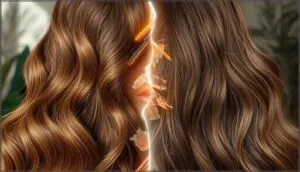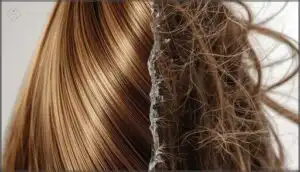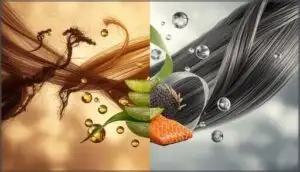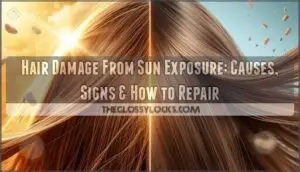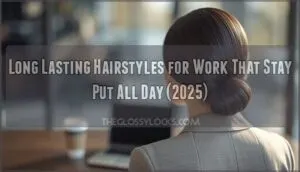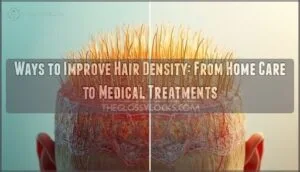This site is supported by our readers. We may earn a commission, at no cost to you, if you purchase through links.

Your hair snaps between your fingers like dried straw, the split ends multiply faster than you can trim them, and that frizz halo refuses to quit no matter how much product you pile on. The damage is real, visible, and frustrating.
But here’s the truth most people don’t understand: while you can’t actually reverse the damage that’s already traveled down your hair shaft—keratin doesn’t regenerate once it’s broken—you can stop new damage cold and coax your follicles into producing healthier strands from this point forward.
The real question isn’t whether damaged hair can be reversed, but rather how far your specific damage has progressed and which combination of strategic repair, protection, and patience will work best for your hair type. Some damage responds beautifully to targeted treatments, while severe cases need more aggressive intervention.
Table Of Contents
Key Takeaways
- You can’t reverse damage that’s already traveled down your hair shaft because keratin doesn’t regenerate once broken, but you can stop new damage and encourage healthier growth from your follicles moving forward.
- Heat styling above 300°F, bleach treatments, and UV radiation cause permanent structural changes to hair by breaking protein bonds, disrupting the cuticle, and increasing protein loss by 2–5 times compared to other environmental factors.
- Deep conditioning masks with keratin and amino acids provide temporary cuticle smoothing that fades after one to two washes, while professional treatments like PRP therapy can increase hair density by up to 45.9 hairs per cm² when follicles remain viable.
- Daily protection strategies—including sulfate-free shampoos, heat protectants below 365°F, UV-blocking leave-in conditioners, and nutrition rich in iron, zinc, and omega fatty acids—prevent further breakdown and support stronger new growth from the root.
Causes and Signs of Damaged Hair
Your hair tells a story, and damage leaves behind clear evidence. Whether it’s from daily styling habits, chemical treatments, or environmental exposure, the signs show up in texture, strength, and overall appearance.
Let’s break down what causes damage and how to spot it before it gets worse.
Common Causes of Hair Damage (Dye, Bleach, Heat, Sun)
Your hair faces threats from every direction. Here’s what’s breaking it down:
- Hair dye risks and chemical exposure: Between 38% and 50% of users report reactions, and hydrogen peroxide decreases shaft strength dramatically.
- Bleach damage: Disrupts the cuticle, creating fissures and exposing the cortex beneath.
- Heat styling: Tools exceeding 300°F permanently alter keratin structure.
- Sun protection failures: UVB radiation causes 2–5 times greater protein loss than other light.
- Hair color maintenance: Regular treatments compound oxidative stress.
Understanding the effects of heat on hair is vital, and learning about heat styling risks can help prevent damage.
How to Identify Damaged Hair (Texture, Breakage, Frizz)
Once you know what’s attacking your strands, spotting the aftermath becomes straightforward. Look for rough hair texture first—47% of women and 30% of men report this classic damage marker.
Breakage signs include split ends in roughly 18% of women and brittle strands that snap under tension. Frizz causes often trace back to humidity response, affecting 14% of women globally, while compromised hair porosity lets moisture escape faster than your hair can hold it.
Understanding hair damage signs is vital for effective hair care.
Understanding Hair Structure and Vulnerabilities
Beneath those damage signs lies your hair’s architecture—95% Keratin Composition forming the Hair Shaft’s foundation. The cuticle (10% of mass) wraps the cortex (75–90%), where disulfide bonds grant Hair Elasticity against mechanical stress.
Lipid Layers seal moisture in, while Melanin Protection filters UV rays that trigger Hair Breakage.
Genetic Factors determine how resilient your Hair Structure remains under assault, making some strands naturally tougher than others when Hair Damage strikes.
Can Damaged Hair Be Reversed?
Once your hair is damaged, you can’t magically undo the harm that’s already been done to the strand itself. However, you do have real options to manage what’s broken and encourage healthier growth from the root.
You can’t reverse hair damage, but you can manage what’s broken and promote healthier new growth
Let’s look at what’s actually possible, what science says about hair regeneration, and where modern treatments can genuinely help.
The Limits of Hair Repair (Permanent Vs. Temporary Fixes)
You need to understand the truth: once heat or chemicals break protein bonds in your hair shaft, topical products can’t reverse permanent damage.
Deep conditioners and masks temporarily smooth the cuticle and improve texture, but effects fade after one to two washes.
For actual hair restoration, you’ll need professional solutions like PRP therapy or follicle transplantation when follicles remain viable.
How Hair Regeneration Works (Follicle Activity, Stem Cells)
Your scalp holds a hidden regenerative system powered by follicular stem cells. These dormant cells activate through three critical pathways:
- WNT/β-catenin signaling triggers stem cell proliferation from the bulge area
- Fibroblast growth factors (FGF-7, FGF-10) coordinate cellular regeneration and new hair germ formation
- BMP proteins regulate the shift from resting to active growth phases
These mechanisms drive natural hair restoration when follicles remain structurally intact.
Scientific Advances in Hair Restoration (Growth Factors, PRP, FUE)
Growth Factor Therapy and PRP injections represent your most evidence-backed options for hair regeneration. Clinical trials show PRP can increase hair density by 45.9 hairs per cm² after three sessions, with 96% of patients achieving fully pigmented regrowth.
FUE transplants boast 95-100% success rates, while emerging treatments like AMP-303 demonstrate 15% increases in non-vellus hair within 60 days.
Effective Strategies to Repair and Prevent Damage
Repairing damaged hair isn’t about one miracle product—it’s about building a consistent routine that tackles the root causes. Your daily habits, from how you wash your hair to what you eat, directly impact your hair’s ability to recover and maintain strength.
Here’s what actually works to restore damaged strands and prevent further breakdown.
Daily Hair Care Routines for Repair
Your daily hair care routine is where the real transformation starts. Consistency matters more than flawlessness. Studies show washing 5–6 times weekly with sulfate-free shampoo reduces flaking and dryness while preserving natural oils essential for repair.
- Use leave-in conditioner with UVB protection to shield hair from environmental damage
- Apply hair serum benefits through moisture locking oils that seal the cuticle
- Practice gentle combing with loop brushes, starting from ends to minimize breakage
- Air dry whenever possible, saving heat styling for special occasions only
Deep Conditioning and Mask Treatments
Think of deep conditioning and hair mask benefits as emergency repair for broken fibers. Treatments containing keratin, amino acids, and argan oil penetrate your hair shaft to rebuild what heat and chemicals destroyed.
Apply a protein-based mask weekly—studies confirm 77% reduction in damage after five sessions. You’re not just coating the surface; you’re strengthening from within.
Heat Styling and Color Maintenance Best Practices
Your flat iron shouldn’t exceed 365°F—anything higher breaks down keratin bonds permanently. Use heat protectant every time you style, and limit thermal tools to 2–3 times weekly.
For color preservation, wash only twice a week with cool water to seal cuticles and lock in pigment.
Heatless styling methods like braiding or foam rollers give you control without the damage.
Nutrition and Scalp Health for Stronger Hair
Your hair is only as strong as what you feed it. Micronutrient balance matters—iron deficiency affects hair growth, while zinc and vitamin D support follicle function. Dietary patterns rich in omega fatty acids from fish and nuts improve scalp health and reduce inflammation.
Consider these hair strengthening essentials:
- Protein-rich foods for keratin production
- Scalp massage to boost circulation
- Hair supplements only when deficiencies are confirmed
Proper hair nourishment starts from within.
Top 5 Products to Restore Damaged Hair
You can’t undo structural damage to your hair shaft, but the right products create a protective barrier that prevents further deterioration while improving texture and appearance.
Strategic formulations target specific vulnerabilities—from cuticle smoothing to moisture retention—giving you visible results without empty promises.
Here are five clinically-backed options that actually work to restore manageability and shine to compromised hair.
1. Color Protecting Mineral Shampoo
Mineral shampoo benefits go beyond basic cleansing—this powerhouse formula cuts color fade by up to 45% after twenty washes. If you’ve invested in salon color, you need UV protection methods and scalp health improvement working in tandem.
This shampoo shields dyed strands from environmental assault while reducing hair damage through gentler surfactants. Hair repair starts at the root, literally—minerals like magnesium strengthen each shaft by 33%, and you’ll notice fewer split ends within four weeks.
For complete hair care that preserves your hair color investment, mineral-based formulas deliver measurable results.
Best For: Anyone with color-treated hair who wants to extend their dye job and keep their color vibrant while strengthening their hair and improving scalp health.
- Cuts color fade by up to 45% after twenty washes, which means you can go longer between salon visits and save money on touch-ups.
- Strengthens hair shafts by 33% with minerals like magnesium, reducing breakage and split ends so your hair looks healthier overall.
- Protects against UV rays and pollution while improving scalp hydration by 35%, tackling multiple hair problems at once.
- Some users report it can strip color instead of protecting it, so results might vary depending on your specific hair type or dye.
- Using too much can leave your hair feeling greasy or weighed down, especially if you have fine hair.
- Not widely available in all stores and often goes out of stock, making it harder to buy consistently.
2. Pureology Hydrate Moisturizing Hair Conditioner
While shampoo sets the stage, your hair repair strategy needs a conditioner that actually delivers. Pureology Hydrate Moisturizing Hair Conditioner addresses dry, color-treated strands with jojoba, green tea, and sage extracts that penetrate deeply without sulfates weighing you down.
This vegan formulation eases detangling and reduces frizz through hydrolyzed soy protein and wheat amino acids—key conditioner ingredients that strengthen hair fibers.
You’ll notice softer, more manageable hair treatment results, though the premium price and strong fragrance aren’t for everyone. For medium to thick hair needing serious moisturizing benefits, it’s worth considering.
Best For: People with medium to thick, dry, color-treated hair who want deep hydration and frizz control without sulfates.
- Deeply moisturizes and detangles with jojoba, green tea, and sage extracts while protecting color vibrancy
- Vegan, sulfate-free formula strengthens hair fibers without weighing them down
- Noticeably reduces frizz and leaves hair softer and more manageable after regular use
- Premium pricing may not fit all budgets
- Strong fragrance isn’t ideal if you prefer unscented or lightly scented products
- Some users with very dry or highly processed hair find it less moisturizing than expected
3. Sun Bum Leave In Hair Conditioner
When you’re battling sun exposure, salt water, and environmental stress, you need a leave-in conditioner that doesn’t quit. Sun Bum’s 3-in-1 formula detangles, conditions, and shields your hair from UV damage through coconut oil, banana extracts, and sunflower seed oil—ingredients that provide genuine hair nourishment and protection.
This lightweight spray works on wet or dry strands without greasiness, making it ideal for color-treated or damaged hair needing daily defense.
At $14.69 for 4 oz, it’s reef-safe, vegan, and paraben-free, though sensitive noses might find the tropical scent overwhelming.
Best For: People with color-treated, sun-exposed, or beach-prone hair who need lightweight protection and detangling without the grease.
- Three-in-one formula detangles, conditions, and provides UV protection in a single spray that works on wet or dry hair.
- Packed with coconut oil, banana extracts, and sunflower seed oil that genuinely nourish while fighting frizz and color fade.
- Vegan, reef-safe, and free of parabens, sulfates, and harsh chemicals, so it’s gentle on your hair and the environment.
- The strong coconut-banana scent might be too intense if you’re sensitive to fragrances.
- At $14.69 for 4 oz, it’s pricier than many drugstore leave-in conditioners.
- May not provide enough moisture for very dry or coarse hair textures that need heavier conditioning.
4. Bumble and Bumble Hairdresser’s Invisible Primer
If you’re layering hair products for real protection, Bumble and Bumble’s Invisible Primer delivers 86% more hydration instantly while cutting frizz by half—even through humidity. Six feather-light oils (including argan and macadamia) create heat styling protection without weighing strands down, and you’ll preserve color for up to 16 washes.
This adaptable hair primer benefits all hair types when applied to damp lengths, though oily scalps should skip the roots. At $32 for 2 oz, it’s premium—but genuinely effective hair repair techniques start here.
Best For: Anyone who heat-styles regularly or has color-treated hair and needs serious frizz control and hydration that actually lasts through the day.
- Delivers measurable results with 86% more hydration instantly and 50% frizz reduction that holds up even in humidity.
- Six lightweight oils protect against heat damage and UV rays while strengthening hair without that heavy, greasy feeling.
- Works as a versatile base layer for other products and keeps color vibrant for up to 16 washes.
- At $32 for just 2 ounces, it’s a premium price point that might not fit every budget.
- Can weigh down fine hair or make roots look greasy if you’re not careful to apply only on lengths and ends.
- A few users find the hydration doesn’t last as long as advertised, depending on their specific hair type.
5. Coconut Argan Hair Oil Treatment
For a finishing treatment that shields without suffocating, this coconut argan blend delivers UV protection and frizz control in one lightweight formula.
You’ll get measurable hair hydration from coconut oil’s proven ability to reduce protein loss by up to 41.8%, while argan oil properties boost shine and prevent split ends during styling.
Though it won’t reverse structural damage, this vegan hair oil benefits all types when used daily or pre-heat styling—offering genuine hair nourishment at $10 for 3 oz.
Best For: People with dry or damaged hair looking for a lightweight daily treatment that protects against heat and UV while adding shine and reducing frizz.
- Scientifically backed coconut oil reduces protein loss and breakage by up to 41.8%, helping maintain hair strength
- Lightweight formula with UV protection works for all hair types without weighing down strands
- Vegan and paraben-free at an affordable $10 price point
- Won’t actually reverse existing structural damage despite what some marketing might suggest
- Small 3 oz bottle means you’ll need to repurchase frequently if using daily
- Coconut scent fades quickly and may not suit people with very oily hair
Frequently Asked Questions (FAQs)
Does hard water worsen hair damage over time?
Like rust accumulating on metal, mineral buildup from hard water gradually weakens hair. Over time, calcium deposits increase hair porosity, triggering hair breakage and scalp irritation that compounds existing hair damage without proper water softening measures.
Can hair supplements actually reverse existing damage?
Supplements don’t reverse existing damage—they can’t repair split ends or broken shafts. However, they strengthen new growth by nourishing follicles with nutrients like biotin and omega-3s, improving future hair health.
How long does damaged hair take to recover?
Recovery timeline depends on damage severity—mild dryness improves within weeks, while severe breakage requires months.
Hair regrowth averages 1 to 5 cm monthly, so complete hair repair often means growing out damaged sections entirely.
Are salon treatments more effective than home remedies?
Salon treatments penetrate deeper into your hair’s cortex using professional-grade formulas, delivering damage reversal methods that last weeks to months.
Home remedies provide temporary surface-level hydration but can’t match professional hair care for structural hair repair.
Will cutting damaged hair make it grow healthier?
Trimming won’t accelerate hair growth rate—that’s determined by your follicles. But removing damaged ends prevents breakage, helping you retain length over time.
Consistent cuts paired with damage prevention strategies support healthier regrowth and better hair health overall.
Conclusion
Treating damaged hair is like nursing a wound—you can’t undo the scar, but you can prevent infection and help healthy tissue grow. The truth is, can damaged hair be reversed? Not the strands already damaged, but you can absolutely stop the destruction and grow stronger hair moving forward.
Your follicles are ready to cooperate. Now it’s your turn to protect what’s coming, trim what’s broken, and commit to the process.
- https://hairfreehairgrow.com/blog/hair-follicle-regeneration/
- https://www.sciencealert.com/baldness-breakthrough-fat-cells-could-be-the-secret-to-rapid-hair-regrowth
- https://www.bernsteinmedical.com/statistics/
- https://buckheadhairrestoration.com/top-hair-restoration-techniques-in-2025/
- https://pmc.ncbi.nlm.nih.gov/articles/PMC10750333/

